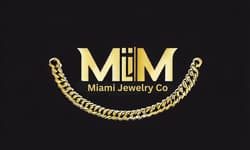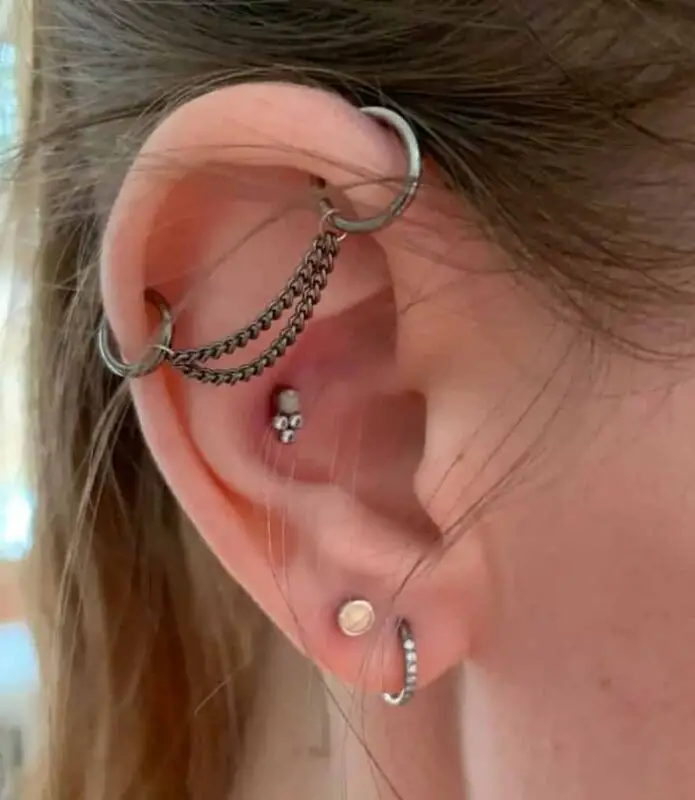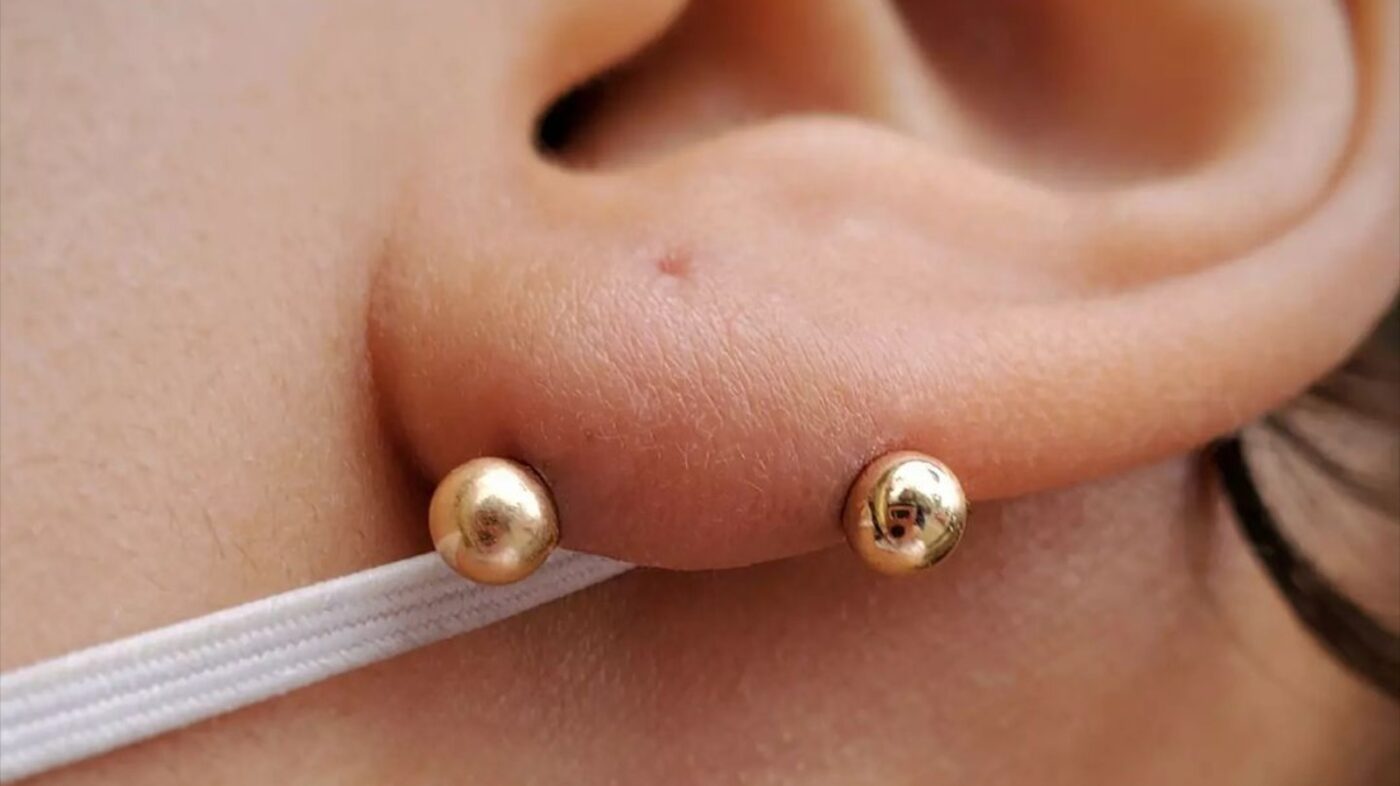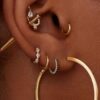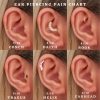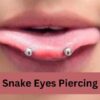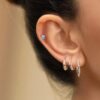Ear Piercing
8 Industrial Piercing Alternatives to Try Out This Year
Industrial piercings are popular among people who want to make a bold statement with their body art. However, they are not for everyone. Industrial piercings can be painful, expensive, and prone to infection and rejection. They also require a lot of care and patience, as they can take up to a year to heal completely.
If you are not ready to commit to an industrial piercing, or if you want to try something different, there are many alternatives that you can choose from.
Here are eight industrial piercing alternatives that you can try out.
Contents
1. Double Helix Piercing
A double helix piercing is a variation of the helix piercing, which is a piercing on the upper rim of the ear. It involves two piercings on the same area, either side by side or slightly apart. You can wear two separate rings, studs, or barbells, or you can connect them with a chain or a curved barbell.
A double helix piercing is a simple and elegant way to adorn your ear. It is less painful and less risky than an industrial piercing, as it involves smaller and fewer holes. It also heals faster, usually within six to eight weeks. However, you should still follow proper aftercare instructions and avoid sleeping on the pierced side.
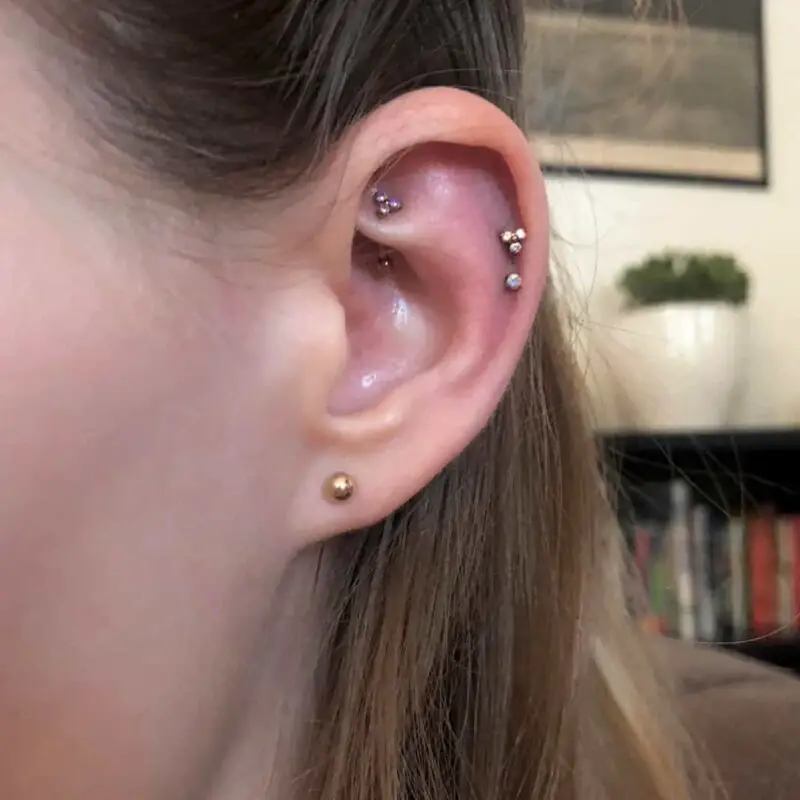
2. Orbital Piercing
An orbital piercing is a type of ear piercing that involves two holes in the same part of the ear, usually on the lobe or the helix. The holes are connected by a single ring that passes through both of them, creating the illusion of an orbit. You can also wear a horseshoe or a circular barbell for a similar effect.
An orbital piercing is a versatile and creative way to decorate your ear. It can be placed on different parts of the ear, depending on your preference and anatomy. It is also less invasive and less complicated than an industrial piercing, as it involves smaller and fewer holes. It usually heals within two to three months, but you should still keep it clean and dry.
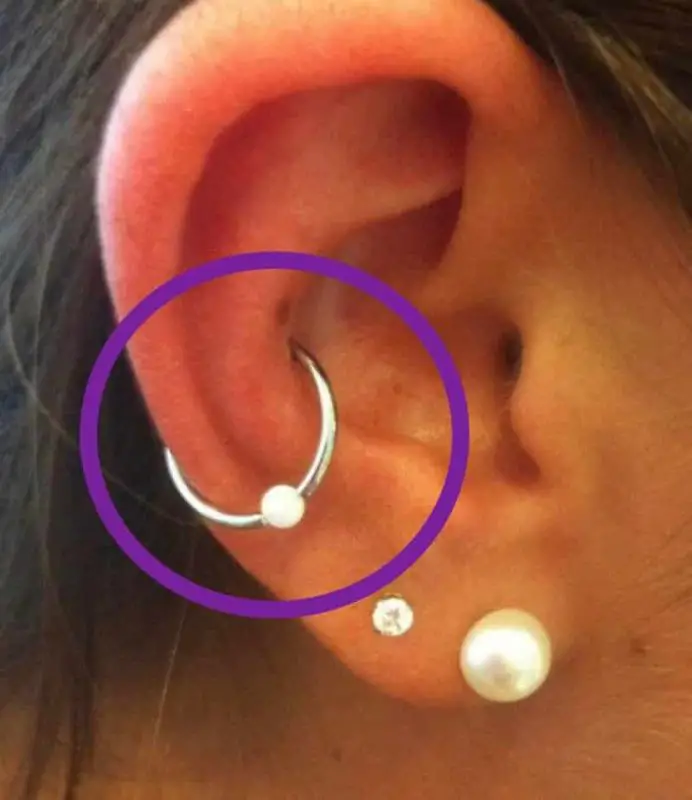
3. Conch Piercing
A conch piercing is a type of ear piercing that involves a hole in the inner or outer part of the ear, where the ear curves inwards. The name comes from the resemblance of the ear to a conch shell. You can wear a ring, a stud, or a barbell on your conch piercing, depending on the location and size of the hole.
A conch piercing is a unique and stylish way to accentuate your ear. It can be placed on different parts of the conch, depending on your preference and anatomy. It is also less visible and less conspicuous than an industrial piercing, as it is hidden inside the ear. However, it can be more painful and more prone to infection, as it involves a thicker and more sensitive area of the ear. It can also take longer to heal, usually between six and nine months.
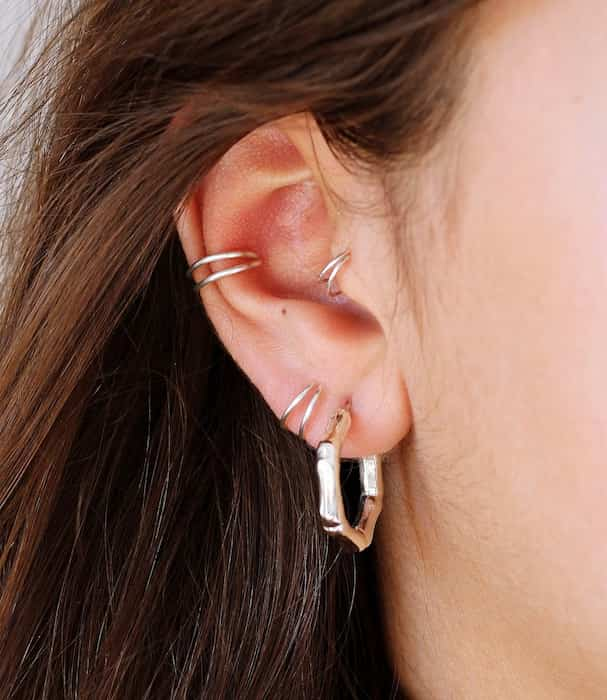
4. Daith Piercing
A daith piercing is a type of ear piercing that involves a hole in the innermost part of the cartilage, where the ear meets the head. The name comes from the Hebrew word for “knowledge” or “wisdom”. You can wear a ring, a stud, or a barbell on your daith piercing, depending on the size and shape of the hole.
A daith piercing is a subtle and sophisticated way to adorn your ear. It can be easily hidden by your hair or your ear, or it can be shown off with cute or quirky jewelry. It is also less common and less mainstream than an industrial piercing, as it is not very noticeable. Some people also believe that a daith piercing can help with migraines, although there is no scientific evidence to support this claim. However, a daith piercing can be very painful and very difficult to perform, as it involves a small and hard-to-reach area of the ear. It can also take longer to heal, usually between six and twelve months.
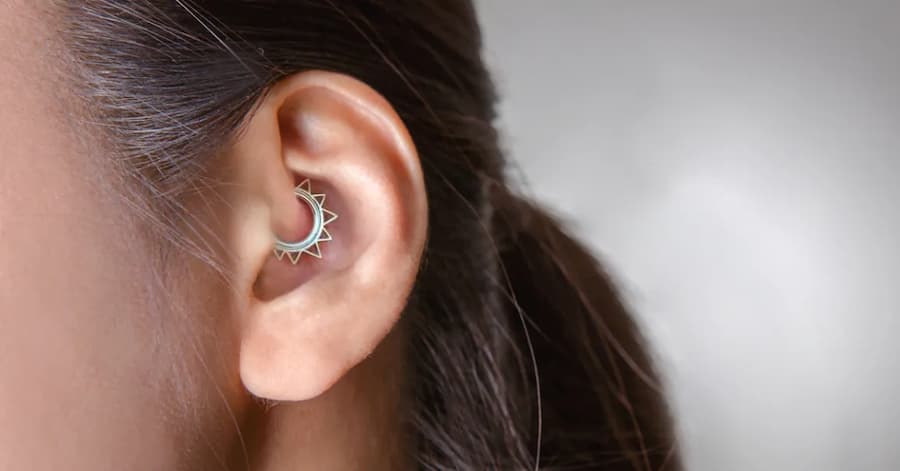
5. Snug Piercing
A snug piercing is a type of ear piercing that involves a hole in the inner part of the cartilage, where the ear folds inwards. The name comes from the snug fit of the jewelry on the ear. You can wear a ring, a stud, or a barbell on your snug piercing, depending on the size and shape of the hole.
A snug piercing is a fun and funky way to spice up your ear. It can be placed on different parts of the snug, depending on your preference and anatomy. It is also less obvious and less flashy than an industrial piercing, as it is tucked inside the ear. However, a snug piercing can be very painful and very tricky to perform, as it involves a thin and curved area of the ear. It can also take longer to heal, usually between six and twelve months.

6. Rook Piercing
A
A rook piercing is a cool and edgy way to enhance your ear. It can be placed on different parts of the rook, depending on your preference and anatomy. It is also less popular and less conventional than an industrial piercing, as it is not very visible. However, a rook piercing can be very painful and very challenging to perform, as it involves a thick and tough area of the ear. It can also take longer to heal, usually between six and nine months.

7. Tragus Piercing
A tragus piercing is a type of ear piercing that involves a hole in the small flap of cartilage that covers the ear canal. The name comes from the Latin word for “goat”, as the tragus resembles a goat’s beard. You can wear a ring, a stud, or a barbell on your tragus piercing, depending on the size and shape of the hole.
A tragus piercing is a cute and trendy way to accessorize your ear. It can be placed on different parts of the tragus, depending on your preference and anatomy. It is also less invasive and less complicated than an industrial piercing, as it involves smaller and fewer holes. It usually heals within two to four months, but you should still avoid touching it or using earphones.

8. Antitragus Piercing
An antitragus piercing is a type of ear piercing that involves a hole on the opposite side of the tragus, on the small flap of cartilage that protrudes above the earlobe. The name comes from the Latin word for “against the goat”, as the antitragus is opposite to the tragus. You can wear a ring, a stud, or a barbell on your antitragus piercing, depending on the size and shape of the hole.
An antitragus piercing is a rare and distinctive way to accessorize your ear. It can be placed on different parts of the antitragus, depending on your preference and anatomy. It is also less common and less conventional than an industrial piercing, as it is not very visible. However, an antitragus piercing can be very painful and very difficult to perform, as it involves a thick and hard area of the ear. It can also take longer to heal, usually between six and nine months.
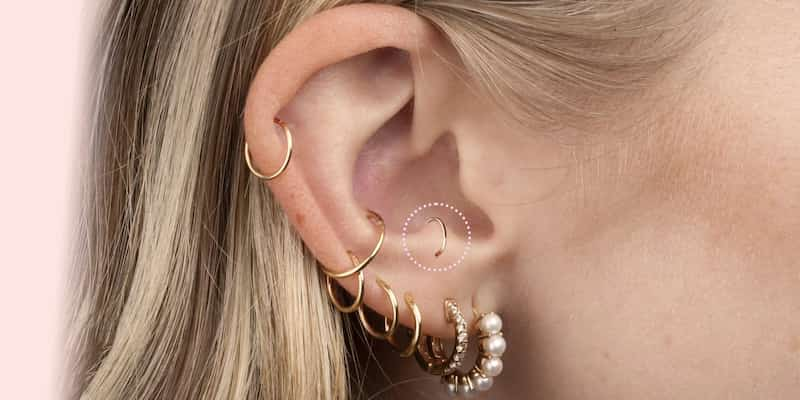
9. Transverse Lobe Piercing
A transverse lobe piercing is a type of ear piercing that involves a hole that goes horizontally through the earlobe, rather than vertically. The name comes from the Latin word for “across”. You can wear a barbell, a curved barbell, or a straight barbell on your transverse lobe piercing, depending on the angle and length of the hole.
A transverse lobe piercing is a modern and trendy way to decorate your ear. It can be placed on different parts of the earlobe, depending on your preference and anatomy. It is also less painful and less risky than an industrial piercing, as it involves a softer and thinner area of the ear. It usually heals within two to three months, but you should still avoid pulling or twisting the jewelry.
10. Faux Industrial Piercing
A faux industrial piercing is a type of ear piercing that mimics the look of an industrial piercing, without actually having two holes connected by a single barbell. Instead, you can wear two separate barbells, one on each hole, that have matching or contrasting ends. You can also wear a fake barbell that clips on the ear, without having any holes at all.
A faux industrial piercing is a fun and easy way to experiment with your ear. It can be placed on different parts of the ear, depending on your preference and anatomy. It is also less painful and less expensive than an industrial piercing, as it involves smaller and fewer holes. It also heals faster, usually within four to six weeks. However, you should still follow proper aftercare instructions and avoid sleeping on the pierced side.
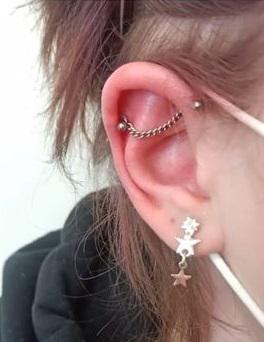
Who I cannot get an industrial piercing?
An industrial piercing is a bold and stylish ear piercing, that connects two holes with a barbell across the upper ear cartilage. It’s a distinctive way to express your personality, but it’s not suitable for everyone. Here’s what to consider before deciding on an industrial piercing:
- Ear Anatomy: Not all ear shapes are ideal for an industrial piercing. As noted by Australia-based piercer Eden Cox, many people lack the necessary ear cartilage structure. A well-defined ridge on the upper ear is essential for supporting the barbell. If your inner ear cartilage is flat, undefined, or protrudes, an industrial piercing might not be feasible, risking irritation or infection.
- Health Conditions: Certain medical conditions affecting blood circulation, the immune system, or healing can complicate an industrial piercing. Conditions like diabetes, hemophilia, or a tendency for keloid scarring increase the risk of complications. Also, avoid this piercing if you’re pregnant, breastfeeding, or planning any medical procedures involving the ear.
- Personal Preference and Maintenance: Consider your comfort with the piercing’s appearance, pain level, cost, and upkeep. An industrial piercing demands significant care, taking up to a year to heal. It involves regular cleaning, avoiding pressure on the pierced area, and not changing the jewelry prematurely. Healing can involve discomfort, swelling, and bleeding. The piercing typically costs between $40 to $100, excluding additional expenses like tips, jewelry, and aftercare products.
FAQs
What is the difference between an industrial piercing and a scaffold piercing?
An industrial piercing and a scaffold piercing are two names for the same type of ear piercing. They both involve two holes connected by a single barbell, usually on the upper cartilage of the ear. The term “industrial” is more common in North America, while the term “scaffold” is more common in Europe and Australia.
How much does an industrial piercing cost?
The cost of an industrial piercing depends on several factors, such as the location, the piercer, the jewelry, and the aftercare products. On average, an industrial piercing can cost anywhere from $40 to $100, not including the tip. You should also factor in the cost of cleaning solutions, saline sprays, and antibacterial ointments, which can add up to another $20 to $30.
How long does an industrial piercing take to heal?
The healing time of an industrial piercing varies from person to person, depending on their health, hygiene, and lifestyle.
What are some benefits of choosing an industrial piercing alternative over a traditional industrial piercing?
Some benefits of choosing an industrial piercing alternative over a traditional industrial piercing are:
- You can have more flexibility and creativity in choosing the placement and configuration of your piercings, depending on your ear anatomy and preference.
- You can avoid some of the drawbacks and risks of a traditional industrial piercing, such as pain, infection, rejection, pressure, and long healing time.
- You can stand out from the crowd and express your individuality with a unique and stylish ear piercing.
How can I find the best industrial piercing alternative for me?
The best way to find the best industrial piercing alternative for you is to consult a professional and experienced piercer who can examine your ear and suggest the most suitable options for you. You can also do some research online and look at some pictures and videos of different industrial piercing alternatives to get some inspiration and ideas.
Can I switch from an industrial piercing alternative to a traditional industrial piercing later?
It depends on the type of industrial piercing alternative you have and the condition of your piercings. Some industrial piercing alternatives, such as a double helix piercing or an orbital piercing, can be easily switched to a traditional industrial piercing by replacing the separate jewelry pieces with a single barbell. However, some industrial piercing alternatives, such as a conch piercing or a daith piercing, may not be compatible with a traditional industrial piercing, as they involve different parts of the ear. You should always consult your piercer before making any changes to your piercings.
Final Words
An industrial piercing, while bold and stylish, is not the ideal choice for everyone due to its potential for pain, cost, and risk of infection. If this doesn’t suit you, consider alternatives like the double helix, orbital, conch, daith, snug, rook, or tragus piercings.
Each offers a unique style and requires different levels of care and healing time. Before deciding, it’s crucial to consult with a professional piercer and adhere to proper aftercare to ensure the health and safety of your ear.
Related:
- Best Piercing Ideas For Your Face Shape
- Piercings for Men
- Ear piercings for Guys Left or Right
- Ear Piercing on Guys

Camila Luna is a passionate jewelry enthusiast and content creator at Miami Jewelry Co. With a focus on providing high-quality, Miami-style jewelry, Camila and her team specialize in a wide range of jewelry that includes bracelets, necklaces, earrings, and more
